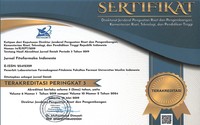IDENTIFIKASI SENYAWA BAHAN ALAM SEBAGAI INHBITOR TIROSIN KINASE EGFR: SKRINING IN SILICO BERBASIS FARMAKOFOR DAN MOLECULAR DOCKING
Abstract
Epidermal growth factor receptor (EGFR) is one of tyrosine kinase that overexpressed in many types of cancer. The ihbiition of EGFR activity has known as a rational target for cancer therapy. However, several EGFR inhibitors have limitations related to resistance problems or reduced tumor response. Therefore, the effort to develop new inhibitors with greater efficacy is very important to overcome the problems.
In the present study, we designed a computational method by combining ligand based pharmacophore modeling and molecular docking for screening the potential natural compounds as EGFR inhibitors. Validation result of ligand based pharmacophore modeling and docking molecular by ROC curves showed that both of these protocols had AUC ≥ 0.7. The Redocking erlotinib to EGFR in our docking protocols gave the RMSD < 2 Å. Therefore, our computational method could be applied for virtual screening.
Initial screening based on pharmacophore modeling obtained 86 out of 179.816 compounds that could be mapped with the pharmacophore features. Further screening through molecular docking showed two compounds had a lower docking score than erlotinib, i.e ZINC00941342 and ZINC72325782. However, by careful analysis of their interaction profiles, only ZINC00941342 which formed hydrogen bonds with Met769, which is known as an EGFR key residue. Additionally, it was also found to form hydrogen with Cys773. Therefore, we recommend ZINC00941342 as a potential EGFR inhibitor.Keywords
Full Text:
PDF (Bahasa Indonesia)References
Allen, W.J., Balius, T.E., Mukherjee, S., Brozell, S.R., Moustakas, D.T., Lang, P.T., Case, D.A., Kuntz, I.D., Rizzo, R.C. (2015) ‘DOCK 6: Impact of New Features and Current Docking Performance’, Journal of Computational Chemistry, 36, pp. 1132-1156. doi: 10.1002/jcc.23905.
Bagnyukova, T., Serebriiskii, Zhou, Y., Hopper-Borge, E. A., Golemis, E. A., Astsaturov, I.
(2010) ‘Chemotherapy and Signaling How can Targeted Therapies Supercharge Cytotoxic
Agents?’, Cancer Biology & Therapy, 10(9), pp. 839-853. doi: 10.4161/cbt.10.9.13738.
Broekman, F., Giovannetti, E., Peters, G. F. (2011) ‘Tyrosine Kinase Inhibitors: MultiTargeted or Single-Targeted?’, World Journal of Clinical Oncology, 2(2), pp. 80-93. doi: 10.5306/wjco.v2.i2.80.
Carrington, C. (2015) ‘Oral Targeted Therapy for Cancer’, Australian Prescriber, 38(5), pp. 171-
doi:10.18773/austprescr.2015.060.
Froimowitz, M. (1993) ‘Hyperchem: A Software Package for Computational Chemistry and Molecular Modeling’, Bio Techniques, 14(6), pp. 1010-1013. PMID:8333944.
Gupta, A. K., Bhunia, S. S., Balaramnavar, V. M., Saxena, A. K. (2011) ‘Pharmacophore Modelling, Molecular Docking and Virtual Ccreening for EGFR (HER 1) Tyrosine Kinase Inhibitors’, SAR and QSAR in Environmental Research, 22, pp. 239-263. doi: 10.1080/1062936X.2010.548830.
Harari P. (2004) ‘Epidermal Growth Factor Receptor Inhibition Strategies in Oncology’,
Endocrine-Related Cancer, 11, pp. 689-708. doi: 10.1677/erc.1.00600.
Hevener, K.E., Zhao, W., Ball, D.M., Babaoglu, K., Qi, J., White, S.W., Lee, R.E. (2009) ‘Validation of Molecular Docking Programs for Virtual Screening against Dihydropteroate Synthase’, Journal of Chemical Information and Modeling, 49(2), pp. 444-460. doi: 10.1021/ci800293n.
Hosmer, D. W., Lemeshow, S., Sturdivant, R. X. (2013) Applied Logistic Regression. 3rd Edition. New York: John Wiley & Sons.
Huang, L., Fu, L. (2015) ‘Mechanisms of Resistance to EGFR Tyrosine Kinase Inhibitor’, Acta
Pharmacetica Sinica B, 5(5), pp. 390-401. doi: 10.1016/j.apsb.2015.07.001.
Irwin, J. J., Shoichet, B. K. (2005) ‘ZINC – A Free Database of Commercially Available Compounds for Virtual Screening’, Journal of Chemical Information and Modeling, 45(1), pp. 177–182. doi: 10.1021/ci049714+.
Koes, D. R., Camacho, C, J. (2012) ‘ZINCPharmer: Pharmacophore Search of the ZINC Database, Nucleic Acids Research, 40, pp. 409-414. doi: 10.1093/nar/gks378.
Li, D-D., Qin, Y-J., Sun, J., Li, J-R., Fang, F., Du, Q-R., Qian, Y., Gong, H-B., Zu, H-L. (2013) ‘Optimization of Substituted 6-Salicyl-4-Anilinoquinazoline Derivatives as Dual EGFR/HER2 Tyrosine Kinase Inhibitors’, PLoS ONE 8(8): e69427. doi:10.1371/journal.pone.0069427.
Mysinger, M. M., Carchia, M., Irwin, J. J., Shoichet, B. K. (2012) ‘Directory of Useful Decoys, Enhanced (DUD-E): Better Ligands and Decoys for Better Benchmarking’, Journal of Medicinal Chemistry, 55(14), pp. 6582-6594. doi: 10.1021/jm300687e.
Nasab, R. R., Mansourian, M., Hassanzadeh, F., Shahlaei, M. (2018) ‘Exploring the Interaction between Epidermal Growth Factor Receptor Tyrosine Kinase and some of the Synthesized Inhibitors using Combination of In-Silico and In-Vitro Cytotoxicity Methods’, Research in Pharmaceutical Science, 13(6), pp. 509-522. doi: 10.4103/1735-5362.245963.
Nurcahyanti, A. (2016) ‘Cervical Cancer: The Case in Indonesia and Natural Product-Based
Therapy’, Journal of Cancer Biology & Research, 4(1), 1078
Rayan, A., Raiyn, J., Falah, M. (2017) ‘Nature is the Best Source of Anticancer Drugs:
Indexing Natural Products for Their Anticancer Bioactivity’, PloS ONE, 12(11), pp. 1-12. doi: 10.1371/journal.pone.0187925.
Seshacharyulu, P., Ponnusamy, M. P., Haridas, D., Jain, M., Ganti, A., Batra, S. K. (2012)
‘Targeting the EGFR Signaling Pathway in Cancer Therapy’, Expert Opinion on Therapeutic
Targets, 16(1), pp. 15-31. doi: 10.1517/14728222.2011.648617.
Sliwoski, G., Kothiwale, S., Meiler, J., Lowe, E. W. (2013) ‘Computational Methods in Drug
Discovery’, Pharmacological Reviews, 66, pp. 334-395. doi: 10.1124/pr.112.007336.
Stamos, J., Sliwkowski, M.X., Eigenbrot, C. (2002) ‘Structure of the Epidermal Growth Factor Receptor Kinase Domain Alone and in Complex with a 4-anilinoquinazoline Inhibitor’, The Journal of Biological Chemistry, 277, pp. 46265-46272. doi: 10.1074/jbc.M207135200.
Wolber, G., Langer, T. (2005) ‘LigandScout: 3-D Pharmacophores Derived from Protein-Bound Ligands and Their Use as Virtual Screening Filters, Journal of Chemical Information and Modeling’, 45(1), pp. 160-169. doi: 10.1021/ci049885e.
Yewale, C., Baradia, D., Vhora, I., Patil, S., Misra, A. (2013) ‘Epidermal Growth Factor
Receptor Targeting in Cancer: a Review of Trends and Strategies’, Biomaterials, 34(34), pp. 8690-8707. doi: 10.1016/j.biomaterials.2013.07.100.
Yuan, H., Ma, Q., Ye, L., Piao, G. (2016) ‘The Traditional Medicine and Modern Medicine
from Natural Product’, Molecules, 21, pp. 2-18. doi: 10.3390/molecules21050559.
Zhang, J., Yang, P. L., Gray, N. S. (2009) ‘Targeting Cancer with Small Molecule Kinase Inhibitors, Nature Reviews Cancer’, 9, pp. 28-39. doi: 10.1038/nrc2559.
DOI: https://doi.org/10.33096/jffi.v8i1.539
Copyright (c) 2021 Frangky Sangande

This work is licensed under a Creative Commons Attribution-ShareAlike 4.0 International License.
Indexed by:
ISSN: 2356-0398 | e-ISSN: 2541-2329
Editor's Address:
Third Floor Pharmacognosy-phytochemistry laboratory building, Urip Sumoharjo road km. 5 Campus II UMI, Makassar, South Sulawesi, Indonesia
Phone: +6281524045514
Fax: +62411425619
E-mail: editorjfi@umi.ac.id

















.jpg)

